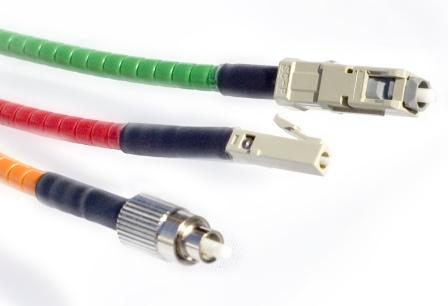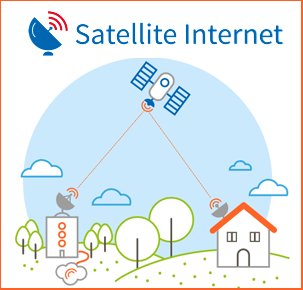Types of Broadband
Broadband generally means high-speed internet access that provides a much faster and more reliable connection than traditional dial-up services. There are several types of broadband connections available and each type of broadband has its own unique advantages and disadvantages, such as cost, availability, and speed. It is important to choose the right type of broadband for your needs and budget.

Fibre optic broadband
This type of broadband uses fibre-optic cables to transmit data, which allows for the fastest speeds, up to 1Gbps or higher. It is considered the most reliable and fastest type of broadband.
With fibre optic broadband, data is transmitted using light, which can travel long distances with minimal signal degradation. This allows for fast and stable internet connections, making it ideal for heavy internet users, such as gamers, streamers, and those who work from home.
Additionally, fibre optic broadband is also less susceptible to interference and more secure than other types of broadband.
Cable broadband
Cable broadband delivers data over cable TV lines and offers speeds ranging from 50 Mbps to 1 Gbps. It is widely available in urban areas and is generally faster and more reliable than DSL broadband.
Cable broadband uses coaxial cable to transmit data, which is different from other types of fixed broadband that use telephone lines or fibre-optic cables.
Cable broadband is widely available in the UK (60%), and the UK’s cable broadband provider Virgin Media offers bundled services that include cable TV, telephone, and internet services. However, the availability of cable broadband can vary depending on location, and some areas may not have access to the service.
DOCSIS 3.1
DOCSIS 3.1 is a technology standard for cable broadband. It stands for Data Over Cable Service Interface Specification, and it specifies the requirements for cable modems and cable modem termination systems (CMTSs) that provide high-speed data transmission over cable television networks.
DOCSIS 3.1 is designed to provide faster and more efficient cable broadband services. It offers several key improvements over previous versions of DOCSIS, including increased network capacity, support for multi-gigabit speeds, and improved reliability and performance.
One of the major benefits of DOCSIS 3.1 is that it allows cable providers to offer much faster broadband speeds compared to previous generations of DOCSIS. With DOCSIS 3.1, cable providers can offer download speeds of up to 10 Gbps and upload speeds of up to 1 Gbps, which is significantly faster than what was possible with previous versions of DOCSIS.
ADSL broadband
ADSL (Asymmetric Digital Subscriber Line) uses telephone lines to provide internet access. It is one of the most common forms of broadband, particularly in older and more established communities.
ADSL provides a moderate speed internet connection and is limited by the distance between the user’s location and the local telephone exchange. The further the distance, the slower the connection will be. Additionally, ADSL can be affected by interference from other devices on the same telephone line, such as telephones or fax machines.
Despite its limitations, ADSL remains a popular option in areas where other broadband technologies are not yet available or are too expensive.
Wireless broadband
Fixed wireless broadband uses wireless signals to connect to the internet, often used in rural areas where other options are not available.

Wireless broadband uses Wi-Fi to provide internet access. It is a good option for those who are always on the go or for those who want to connect multiple devices at once. However, the speed and reliability of wireless broadband can be affected by distance from the router and the number of devices connected to the network.
Satellite broadband
Satellite broadband uses satellites to provide internet access and is often used in rural or remote areas where other types of broadband are not available. It can be slow and expensive, but it is a good option for the premises with no access to other broadband options.

With satellite broadband, a satellite dish is installed at the user’s location, which then receives and transmits data to and from the satellite.
Satellite broadband generally has lower speeds and higher latency compared to fibre optic or cable broadband. It also tends to be more expensive and can be affected by weather conditions, such as heavy rain or snow. However, it is still a viable option for those who need internet access in remote areas.
Mobile Broadband
Mobile broadband uses mobile networks, such as 4G and 5G, to provide internet access. It is often used as a backup or supplementary option for those who need internet access on the go, or for those who do not have access to a fixed broadband connection.

Mobile broadband is convenient as it allows users to access the internet from anywhere with mobile network coverage. It can also be used as a primary internet connection for those who travel frequently or for small businesses that need internet access for their employees while on the road.
Speed and reliability of mobile broadband can vary depending on the strength of the mobile network signal and the number of users on the network at any given time. Additionally, mobile broadband can be more expensive compared to fixed broadband, especially if a large amount of data is used. Nevertheless, mobile broadband remains a popular and useful option for those who need internet access on the go.
4G broadband
4G broadband refers to a type of mobile broadband that uses the fourth-generation (4G) mobile network technology to provide internet access. 4G is faster and more reliable than previous generations of mobile broadband, such as 3G, and offers speeds that are comparable to many fixed broadband connections.
The speed and reliability of 4G broadband can vary depending on the strength of the 4G network signal and the number of users on the network at any given time.
4G speeds
Real-world 4G speeds can vary depending on many factors, such as the strength of the 4G signal, the number of users on the network at any given time, and the type of 4G network (LTE, LTE-Advanced, LTE-Advanced Pro, etc.).
In general, 4G networks offer peak speeds of up to several hundred megabits per second, making them much faster than 3G networks. This can result in faster download and upload speeds, lower latency, and improved overall performance for activities such as streaming, gaming, and video conferencing.
4G networks are widely available in many parts of the world and continue to improve and expand, providing faster and more reliable connections for users.
5G broadband
5G broadband refers to a type of mobile broadband that uses the fifth-generation (5G) mobile network technology to provide internet access. 5G is designed to offer higher speeds, lower latency, and more reliable connections compared to previous generations of mobile broadband, such as 4G.
Additionally, 5G broadband can be more expensive compared to fixed broadband, especially if a large amount of data is used. Nevertheless, 5G broadband is considered the future of mobile internet and is expected to provide faster and more reliable connections than previous generations of mobile broadband.
5G speeds
5G technology is designed to offer significantly higher speeds compared to previous generations of mobile broadband, such as 4G.
In general, 5G networks offer peak speeds of up to several gigabits per second, making them much faster than 4G networks. This can result in faster download and upload speeds, lower latency, and improved overall performance for activities such as streaming, gaming, and video conferencing.
Currently, 5G coverage is limited in many areas, and speeds may be slower in some locations compared to others. However, 5G networks are expected to expand and improve in the coming years, providing faster and more reliable connections for users.
Why there are so many types of broadband?
There are several reasons why there are many types of broadband:
- Availability: Different types of broadband are available in different areas based on infrastructure and technology. For example, fibre-optic broadband is not available in all areas, but cable or ADSL broadband might be.
- Speed and Reliability: Different types of broadband offer different speeds and levels of reliability, which is important for different types of internet usage. For example, fibre-optic broadband offers the fastest speeds, which is ideal for high-bandwidth applications such as 4K streaming or gaming.
- Cost: Different types of broadband have different costs, which can vary based on the level of service, the speed, and the provider. Some types of broadband, such as satellite broadband, can be more expensive than others.
- Consumer demand: There is a wide range of consumer demand for all the types of broadband, and various types of broadband meet the needs of different types of consumers. For example, some consumers may prefer wireless broadband for its mobility, while others may prefer fibre broadband for its speed and reliability.
- Technological advancements: The telecommunications industry is constantly evolving and new technologies are being developed all the time. This means that new types of broadband are emerging all the time, offering different speeds, features, and costs.
